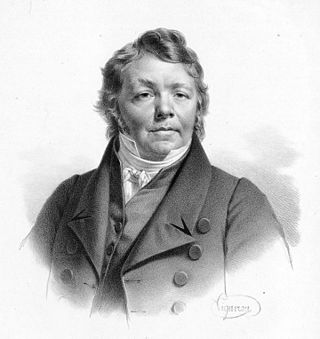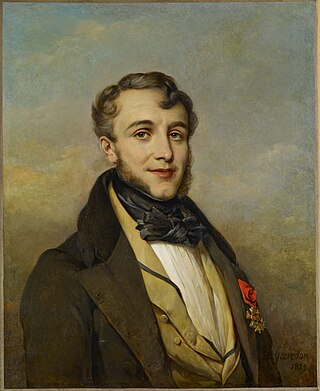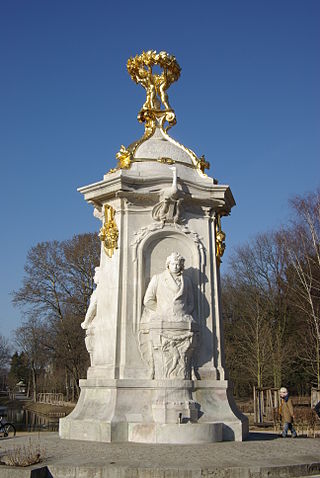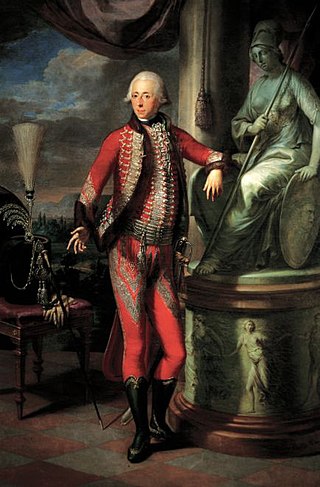
Adamus List (Hungarian : Liszt Ádám; [1] 16 December 1776 –28 August 1827) was the father of composer and pianist Franz Liszt.

Adamus List (Hungarian : Liszt Ádám; [1] 16 December 1776 –28 August 1827) was the father of composer and pianist Franz Liszt.
As the second child of Georg Adam List and Katharina (née Baumann), [2] he was born in Nemesvölgy (today Edelstal, Austria), a village close to the Austrian border in the Kingdom of Hungary. His family was of Danube Swabian German descent. There are Germanic, Slavic and Magyar claims of the Liszt family. They lived in Márcz, Nagymarton and also Malacka, Kingdom of Hungary (today Marz, Mattersburg in Austria and Malacky in Slovakia).
Georg was in service for the Hungarian Nikolaus II, Prince Esterházy and both he and his son, Adam, were Hungarian citizens. The family lived mostly in the German-speaking parts of Hungary, which is why they had only rudimentary knowledge of Hungarian. Franz tried to learn the common tongue of his kingdom in the 1870s, but in spite of his great language skills he could not reach fluency level.
In his youth, Adam changed his surname "List" to the spelling "Liszt", according to Hungarian pronunciation. In his lifetime, Latin, not Hungarian, was the administrative language of the multi-ethnic Kingdom of Hungary, hence the recorded Latinised name "Adamus". After the great success of his son Franz, the father Georg also started to use the surname Liszt in the 1820s. Other family members also adapted this form, e.g. Adam's brother, Eduard, father of Franz von Liszt.
As a teenager, Liszt played cello in the House of Eszterházy summer orchestra under the direction of Joseph Haydn. He was also an amateur pianist, and played the organ and violin and sang in a choir. His brother Eduard and one sister Barbara also showed great musical talents, as did their father Georg, who worked as an organist and played the piano and violin, but they had few resources for musical education other than within the family. After graduating from the Archigymnasium Regium Posoniense (today Gamča, Slovakia), in Pressburg (Pozsony, today's Bratislava), Liszt entered the Franciscan Order, but two years later, by his petition in 1797, was released from the order. He still kept a close relationship with the order, which probably gave him the inspiration to name his son Franz.
An attempt by Liszt to continue as a student of philosophy at the University of Pozsony ended in the first year due to financial reasons. He had to look for a job, and in 1798 became a clerk at the Esterházy estate in Fraknóváralja (today Forchtenstein, Austria). After two years, Liszt was transferred to Kapuvár where he was missing the musical atmosphere at Kismarton (today Eisenstadt, Austria). He started to compose music and dedicate it to the Prince in order to be transferred back to the Western part of Sopron County. Only in 1805 did he finally succeed in getting a job at the court in Kismarton. The years in Kismarton were his happy years. In his spare time, he played cello in the orchestra led by Johann Nepomuk Hummel, the successor of Haydn, and had the opportunity to work with many musicians who came to Kismarton to perform, including Cherubini and Beethoven. This happy time ended when Liszt was transferred to the Esterházy estate of Doborján (today Raiding, Austria) in 1809, as an overseer of the herd of about 50,000 sheep (Rentmeister der Fürstlich Esterházyschen Schäferei). Doborján, only 30 miles from Kismarton, was a rather provincial place.
While visiting his father in Nagymarton (today Mattersburg, Austria) in the summer of 1810, Liszt met Anna Lager, daughter of baker Matthias Lager and his second wife Francisca Lager, nee Schumann, who had recently moved from Vienna to Nagymarton. Their marriage took place in the parish of Lók (today Unterfrauenhaid, Austria) on 11 January 1811. [3]
The only child of the couple, Franz Liszt, was born on 22 October 1811. Liszt's father Georg wrote to prince Esterházy in 1812 that Adam had three more children, but there is no other documentation about this, and it seems unlikely. [4]
At his house in Doborján, Liszt staged chamber concerts. When Franz was 5, Adam started to teach him music. When his fame grew, sponsors could finance private education in Vienna for the young Franz. Franz's father stayed close to his son throughout his travels to Vienna and Paris, where they settled in 1823. The purpose was to let Franz study at the famous Conservatoire de Paris, but Cherubini told them that foreigners were not admitted. (Long after this piece of unintentional satire, Liszt would always scorn the conservatoires and their products). So Liszt continued to teach his son, with a rigid schedule of practicing Bach and other composers on the piano, with transposition of fugues and other daily technique improving exercises. After resigning from the Esterhazys' service Liszt spent most of his time as the manager of his son's career, with tours in many European countries. Franz found his father's supervision quite demanding. (He may also have become the main breadwinner through giving lessons and concerts). Liszt was a skillful business manager. It is possible that the father wanted the opportunities for his son that service with the Esterhazys had blocked for him. Liszt secured him lessons with Paer (composition), Salieri (singing) and, mainly, Czerny (piano). Liszt had known Czerny and Beethoven from his own musical days. Through Czerny, Liszt secured his son a meeting with Beethoven and Czerny seems to have persuaded his master to go to a concert where the young man was playing. Franz was devastated by his father's death and withdrew to a monastery for a time. His mother, Anna Lager came to look after him in Paris where she remained until her death in the 1860s. He soon became an established performer and teacher who was able to introduce Chopin to the musical world on his arrival in Paris in 1830.
The elder Liszt was the main influence on Franz in his early years, as both teacher and manager. Franz's full musical maturity was reached after his father died, when he heard the works of such composers as Mendelssohn, Schubert and Schumann. The big influence on his performing style after his father's death came from his meetings with the forty-year-old Paganini. Though he always honored the memory of Adam Liszt, who had been accused by the French gutter press of exploiting the child prodigy, he never visited his grave at Boulogne-sur-Mer.
Liszt died in 1827 in Boulogne-sur-Mer at the age of 50 when Franz was 15 years old. The two were staying at a retreat centre for Franz to rest after a physician's order; however, the father became fatally ill with typhoid fever, died, and was buried there. Franz composed a funeral piece for his father's funeral service.

AntonDiabelli was an Austrian music publisher, editor and composer. Best known in his time as a publisher, he is most familiar today as the composer of the waltz on which Ludwig van Beethoven wrote his set of thirty-three Diabelli Variations.

Johann Georg Albrechtsberger was an Austrian composer, organist, and music theorist, and one of the teachers of Ludwig van Beethoven. He was also a friend of Haydn and Mozart.

Franz Liszt was a Hungarian composer, virtuoso pianist, conductor and teacher of the Romantic period. With a diverse body of work spanning more than six decades, he is considered to be one of the most prolific and influential composers of his era, and his piano works continue to be widely performed and recorded.

Sopron is a city in Hungary on the Austrian border, near Lake Neusiedl/Lake Fertő.

Carl Czerny was an Austrian composer, teacher, and pianist of Czech origin whose music spanned the late Classical and early Romantic eras. His vast musical production amounted to over a thousand works and his books of studies for the piano are still widely used in piano teaching. He was one of Ludwig van Beethoven's best-known pupils and would later on be one of the main teachers of Franz Liszt.

Johann Nepomuk Hummel was an Austrian composer and virtuoso pianist. His music reflects the transition from the Classical to the Romantic musical era. He was a pupil of Mozart, Salieri and Haydn. Hummel significantly influenced later piano music of the 19th century, particularly in the works of Chopin, Liszt and Mendelssohn.

Eisenstadt is the capital city of the Austrian state of Burgenland. With a population of 15,074, it is the smallest state capital and the 38th-largest city in Austria overall. It lies at the foot of the Leitha Mountains hill range.

The House of Esterházy, also spelled Eszterházy, is a Hungarian noble family with origins in the Middle Ages. From the 17th century, the Esterházys were the greatest landowner magnates of the Kingdom of Hungary, during the time that it was part of the Habsburg monarchy and later Austria-Hungary. During the history of the Habsburg Empire, the Esterházy family were consistently loyal to the Habsburg rulers. The Esterházys received the title of Graf (Count) in 1626, and the Forchtenstein line received the title of Fürst (Prince) from the Holy Roman Emperor in 1712.

Friedrich Wilhelm Michael Kalkbrenner, also known as Frédéric Kalkbrenner, was a pianist, composer, piano teacher and piano manufacturer. German by birth, Kalkbrenner studied at the Conservatoire de Paris, starting at a young age and eventually settled in Paris, where he lived until his death in 1849. Kalkbrenner composed more than 200 piano works, as well as many piano concertos and operas.

During the course of his lifetime, Ludwig van Beethoven (1770–1827) established relationships with many of his musical contemporaries. Beethoven was notoriously temperamental, eccentric and difficult to get along with; the history of his many relationships is replete with arguments, misunderstandings, and reconciliations. Beethoven had well-known quarrels with his one-time teachers, Joseph Haydn and Antonio Salieri, with the piano virtuoso and composer Johann Nepomuk Hummel, and the German composer Carl Maria von Weber. Conversely, he regarded Franz Schubert positively, praising the latter's compositions.

The Siebengemeinden were seven Jewish communities located in Kismarton and its surrounding area. The groups are known as Sheva Kehillot in Hebrew.
Gregor Joseph Werner was an Austrian composer of the Baroque period, best known as the predecessor of Joseph Haydn as the Kapellmeister of the Hungarian Esterházy family. Few of Werner's works survive to the present day, and he is mostly remembered for his troubled relationship with Haydn.

Dreams of Love – Liszt is a Hungarian-Soviet epic musical/drama produced and directed by Márton Keleti, based on the biography of the Hungarian composer and pianist Franz Liszt.

Pál Kitaibel was a Hungarian botanist and chemist.

Paul I, 1st Prince Esterházy of Galántha, was the first Prince Esterházy of Galántha from 1687 to 1713, Palatine of the Kingdom of Hungary from 1681 to 1713, and an Imperial Field Marshal. Paul was also an accomplished poet, harpsichordist, and composer. He actively participated in various battles against the Ottoman Turks during the Fourth Austro-Turkish War (1663–1664) and the Great Turkish War (1683–1699). Paul is credited with establishing the wealth, power, and influence of the Princely House of Esterházy.

Nicholas II, Prince Esterházy was a Hungarian prince. He served the Austrian Empire and was a member of the famous Esterházy family. He is especially remembered for his art collection and for his role as the last patron of Joseph Haydn.

Christoph Sonnleithner was an Austrian jurist and composer. He was the father of Ignaz von Sonnleithner and Joseph Sonnleithner. His daughter Anna was the mother of Franz Grillparzer.

Baron, later Count Nikolaus Esterházy de Galántha was the founder of the West-Hungarian noble House of Esterházy which became one of the grandest and most influential aristocratic families of the Kingdom of Hungary.

The Liszthaus Raiding is the building where Franz Liszt was born in 1811 which has been a museum since 1979. It is located in Raiding, a town in Burgenland province of Austria.

Countess Éva Thököly de Késmárk, was the second wife of Paul I, Prince Esterházy. Éva was the youngest daughter of Count István Thököly and Mária Gyulaffy. She is the sister of Imre Thököly, Prince of Transylvania. Through her marriage, she became the first Princess Esterházy of Galantha in 1687.